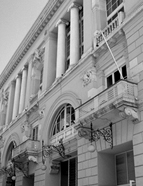

................................
The impact of the SGL's projects on the government was significantly facilitated when its first President, the Viscount of São Januário, took office as Minister of the Navy and Overseas Affairs in 1880. The merger of the SGL with the Central Permanent Commission on Geography (CCPG), ordered by the Royal Decree of 12 August 1880, marked the beginning of institutional cooperation, transforming the privately initiated Society into an advisory scientific and technical body for the Portuguese state on colonial matters. With this consolidation, the former official commission was renamed the Central Commission on Geography (CCG), maintaining its original organisation and responsibilities, and was housed within the SGL’s facilities. Cooperation with the state required the SGL to provide all information and opinions requested on relevant matters, although this did not exhaust the scope of collaboration. A new partnership agreement, ratified by a decree on 10 March 1882, entrusted the Colonial Museum of Lisbon (established on 17 May 1870, near the Naval Arsenal) to the SGL. In July 1881, the General Assembly of the SGL approved a document titled Appeal to the Portuguese People in the Name of Honour, Law, Interest, and the Future of the Nation , aimed at achieving several objectives: launching a permanent national subscription to establish civilising stations in African territories; outlining its colonisation plans through the dissemination of a map that highlighted in dark colour the area between Angola and Mozambique, revisiting the coast-to-coast project proposed in 1616 by Luís Mendes de Vasconcelos, then governor of Angola; raising public awareness of international competition in colonial imperialism in Africa; attracting investors to execute a comprehensive economic plan for the colonies; and clearly defining the locations of priority projects through comparative territorial analysis. This ambitious, comprehensive, and structured plan, unparalleled among European powers in 1881 for the Central-Southern African region, lacked, however, the means for implementation. The "Rose-Coloured Map," released in 1886, was a revised version of the 1881 map, updated to reflect claims redefined during the Berlin Conference, in which Luciano Cordeiro actively participated. At the April 1889 session, the SGL assessed the impact of its efforts to raise awareness and motivate public opinion and economic agents on African issues, concluding: “The country responds with utmost indifference to the concerns and efforts of the government (...). For years, conferences have been held in this house, reports published (...) but neither the information nor the prospect of interest (...) influences the general public or our capitalists in particular.” The session of 20 January 1890 was marked by mourning the British ultimatum regarding Portuguese claims in Southern Africa. Despite this, Luciano Cordeiro highlighted “the many manifestations of public applause and encouragement” that the SGL received at the time. With the significant changes to international colonial law in the last two decades of the 19th century, the SGL refocused its activities on consolidating technical-scientific objectives, prioritising geographical studies and other areas of knowledge aligned with deepening colonial research and understanding
This work is financed by national funds through FCT - Foundation for Science and Technology, I.P, in the scope of the projects UIDB/04311/2020 and UIDP/04311/2020.
